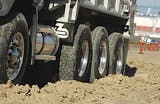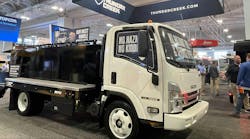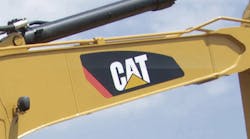With the high cost of tires today, it is obvious that tire tread patterns are not designed for cosmetic reasons. Tire treads serve a specific purpose, especially in the often hostile environment of off-highway and construction applications.
Of the seven general tread categories (two are urban and transit service), five are more focused on applications most familiar to construction firms: over the road, mixed service, all position, steer axle, and drive axle. In any fleet operation, of course, equipment managers follow the recommendations of their tire supplier when it comes to selecting the right tread pattern for the right job.
At last year's Vehicle Maintenance Management Conference in Seattle, however, general guidelines for matching tread patterns with specific applications were presented.
Since some construction fleets also have over-the-road vehicles, it is appropriate to include "highway tires" in the overall mix. Designed to operate on paved surfaces on local and long-distance runs, the rubber compound, tread pattern and casings of highway tires are generally made for long wear, fuel economy, and retreading. Some OTR tires can be used in any position (steering, drive or trailer), while others are limited to specific positions.
Mixed-service tires are designed to run on a wide variety of surfaces ranging from paved roadways to gravel to dirt. As the name implies, vehicles that perform mixed services use this type of tire and tread. Not only are they suitable for highway speeds, they have enhanced tread wear for travel on abrasive surfaces and therefore resist tread chipping and chunking caused by rocks, wood and other damaging objects. Waste hauling, construction site deliveries, and logging are typical applications.
All-position tires typically have rib tread design that provides all-weather traction and improved fuel economy. These tires can be used in all positions, such as the steering axle. A typical application would be on Class 6 and 7 trucks. They are also suitable for use in high-severity situations where the wear rate is high. They function satisfactorily as steer tires, on vehicles with short wheelbases, high turn frequency, and heavy steer axle loads. Many fleet managers often simplify tire inventory by placing all-position tires on both steer and drive axles.
Steer-axle tires are engineered for line haul applications and are designed to resist irregular wear. A typical application for these slow-wear-rate tires is on tractors and vehicles with low turning frequency duty cycles. The tread pattern design allows each rib to carry an equal share of the load and that, of course, means the tire lasts longer.
Drive-axle tires have deep treads and patterns for extra traction and longer tread life. In-line haul service, for instance, would use cross bar or lug type highway drive tires for high torque situations such as a single tractor pulling double trailers.
In specifying a particular tire-tread pattern, fleet managers should not base their purchasing decision on a "worst-case scenario," says Curtis Decker, Continental Tire's national manager, fleet engineering. Managers should be realistic when it comes to application. "They should sit down and take a look at their average application to see what their main need is," he says.
"I understand why they look at a worst-case scenario. It's very painful to have a perfectly good piece of equipment with no flats, no mechanical problems, and still not be able to use it to go off-road because the tire tread pattern isn't right. In the back of their minds, these fleet managers tell themselves, 'This will never happen to me again.'" Decker suggests that managers are throwing away money by not spec'ing the right tread.
Decker also says fleet managers can have a great influence in tread design. One of Continental's tires, the HDO, came out of a meeting the company had with a fleet operator. "During a meeting five years ago, a fleet involved in extremely heavy-duty forestry applications told us what it needed, and we designed the HDO," Decker says. The tire was built exclusively for the fleet for two years and worked so well that Continental made the design available to a wider off-road market, Decker says.
Equipment managers need to evaluate whether their particular application requires a traction pattern or a wearing pattern, says Roger Best, senior field engineer, Bridgestone/Firestone Off-Road. "In heavy rock, you get deep cuts to the tire," he says. "If the vehicle is going to run 30 or 40 mph, you might consider a tread pattern that will not be susceptible to heat separation."
Although variables seem endless in selecting the right tread pattern for the right work environment (Bridgestone has 30 different patterns alone), Best provides some examples. For quarry applications, Bridgestone has a heavy-duty tire, the VRQP, designed for use on small or medium dump trucks.
"This tire would be used by a customer using an end dump to haul rock out of a quarry pit," Best says. "Tread patterns for this application are designed for shorter hauls at lower speeds, say less than 20 mph and 75-ton payloads."
This tread design isn't meant to provide a lot of traction, he says. "Generally the roads are made of rock, which wears the tires out, so customers want a design that resists wear."
Best says computer-aided design programs enable tire manufacturers to design tread patterns for a given application. "We look at how the tire runs on the road and then design the grooves in the pattern," he says. "We determine where they should be placed on the tire to optimize the wear. We look at how the footprint is concentrated when it touches the ground and other factors."
Tread patterns differ according to the functions they fulfill, says Tim Miller, marketing communications manager for commercial tires, Goodyear Tire and Rubber. "Determining a specific tread pattern for a specific application is an evolutionary thing rather than revolutionary," he says. "We typically take something we've used in the past and, over time, gather comments and information on tread wear from the field. Sometimes we find out we need to go in a little different direction when it comes to tread-pattern design. Sometimes the tread pattern is cosmetic and sometimes it is an actually physical, technical need that the tire has."
Construction firms should look for "chipping and chunking," Miller says. "From a rubber technology point of view, you're going to get great wear out of a highway tire, but if you use that same tread compound on an off-road tire, it will chip and chunk and cause other problems."
In selecting a tire-tread pattern, you can't choose one out of a catalog, Miller says. "You need historical background to know if it's going to work." The best source is the contractor's tire supplier, he says. That source, linked with the contractor's own fleet history of tire wear, can take fleet managers where they want to go.
It ultimately comes down to how you plan to use the tire. "In matching tire to application," Best says, "you need to look at the whole package: tread, type of pattern, casing construction, where the tire will run, speeds, temperatures, climate and road surface."






